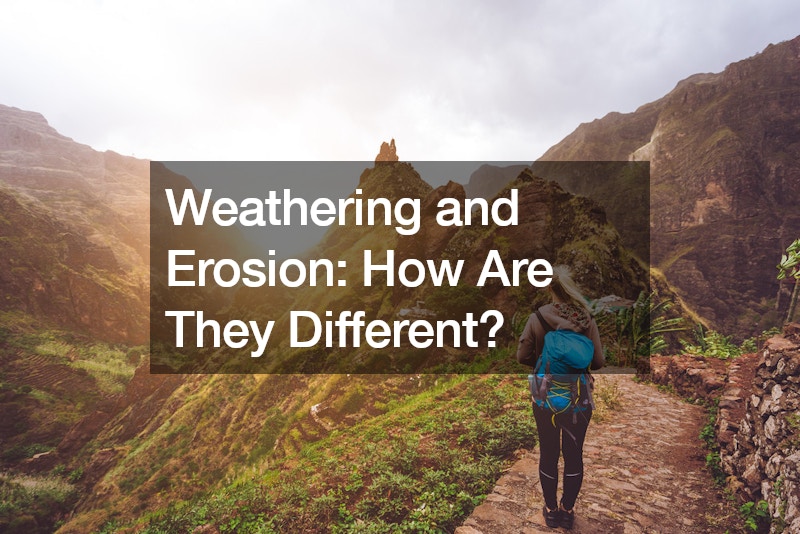Weathering and erosion are two fundamental geological processes that shape the Earth’s surface over time. While they may seem similar at first glance, they operate in distinct ways, each playing a crucial role in sculpting landscapes and landforms. Understanding the differences between weathering and erosion is essential for comprehending the dynamic forces that continually reshape our planet.
Weathering: Breaking Down Rocks
Weathering is the process by which rocks are broken down, decomposed, or altered physically and chemically. It is the initial step in the transformation of solid rock into sediment.
There are three main types of weathering: chemical, mechanical, and biological.
Chemical weathering occurs when minerals within rocks react with air, water, or acids, leading to their dissolution or alteration. For example, the exposure of limestone to acidic rainwater can result in the dissolution of calcium carbonate, leading to the formation of karst landscapes characterized by sinkholes and caves.
Mechanical weathering, on the other hand, involves physical processes that break rocks into smaller fragments without altering their chemical composition. Frost action, where water seeps into cracks in rocks and expands upon freezing, is a common mechanical weathering process. The repeated freezing and thawing cycles can cause rocks to fragment into smaller pieces over time.
Biological weathering is driven by the activities of living organisms, such as plants, animals, and microbes. Tree roots can exert pressure on rocks, causing them to crack and break apart, while burrowing animals can contribute to the physical breakdown of rocks through their activities.
Erosion: Moving and Transporting Sediment
Erosion is the process by which weathered rock and sediment are transported from one place to another by natural agents such as water, wind, ice, and gravity. Unlike weathering, which primarily acts in place, erosion involves the movement of material.
Water erosion occurs through the action of rainfall, rivers, waves, and floods. Rivers carry sediment downstream, gradually shaping valleys and canyons over time. Coastal erosion, driven by the relentless pounding of waves against shorelines, can result in the formation of sea cliffs, beaches, and coastal dunes.
Wind erosion occurs in arid and semi-arid regions where loose, dry soil is susceptible to being lifted and carried by the wind. Dust storms can transport vast quantities of sediment over long distances, leading to soil loss and degradation.
Glacial erosion is the process by which glaciers carve out valleys and fjords as they advance and retreat over the landscape. The immense weight and movement of glaciers can pluck rocks from the ground and grind them into fine sediment as the ice flows downhill.
Gravity-induced erosion includes mass movement processes such as landslides, rockfalls, and slumps, where gravity causes rocks and sediment to move downslope. Human activities such as deforestation, mining, and construction can also contribute to erosion by disturbing soil and vegetation cover.
Understanding the Differences
While weathering and erosion are closely related processes, they operate at different scales and timeframes. Weathering acts to break down rocks into smaller particles, while erosion transports these particles to new locations. Together, these processes shape the Earth’s surface, forming diverse landscapes and landforms.
In practical terms, understanding the differences between weathering and erosion is crucial for land management and conservation efforts. Erosion control measures, such as terracing, vegetation planting, and soil stabilization, aim to mitigate the effects of erosion by reducing the transport of sediment and protecting vulnerable areas from degradation.
By recognizing the distinct mechanisms of weathering and erosion, scientists, engineers, and land managers can develop effective strategies for sustainable land use and environmental stewardship. Through careful planning and implementation of erosion control measures, we can preserve the integrity of our landscapes for future generations.
Human Impact on Weathering and Erosion
Human activities have a profound impact on the processes of weathering and erosion, often accelerating natural phenomena and leading to widespread environmental degradation. Urbanization, deforestation, agriculture, and mining are among the primary contributors to human-induced alterations of landscapes.
Urbanization significantly alters natural landscapes, replacing vegetation and soil with impervious surfaces such as concrete and asphalt. The increased surface runoff associated with urban areas can intensify erosion processes, leading to soil loss, sedimentation in water bodies, and destabilization of slopes. Furthermore, urban heat islands exacerbate weathering by promoting thermal expansion and contraction of building materials, hastening their deterioration.
Deforestation, particularly in tropical regions, disrupts natural ecosystems and exposes soil to erosive forces. Without tree cover to protect against rainfall and root systems to stabilize the soil, erosion rates escalate, leading to loss of fertile topsoil, increased sedimentation in rivers, and heightened susceptibility to landslides. The clearance of forests for agricultural purposes further exacerbates erosion, as monoculture crops offer limited soil protection and root anchorage.
Agricultural practices, including plowing, monocropping, and overgrazing, can significantly impact soil structure and increase vulnerability to erosion. The removal of natural vegetation disrupts soil stability, while intensive tilling and the use of heavy machinery exacerbate compaction and erosion. Soil erosion not only diminishes agricultural productivity but also contributes to sedimentation in water bodies, nutrient runoff, and degradation of aquatic ecosystems.
Efforts to mitigate the human impact on weathering and erosion include implementing erosion control measures, restoring degraded landscapes, and promoting sustainable land management practices. By addressing the root causes of environmental degradation, society can work towards preserving natural resources and safeguarding ecosystems for future generations.
.

